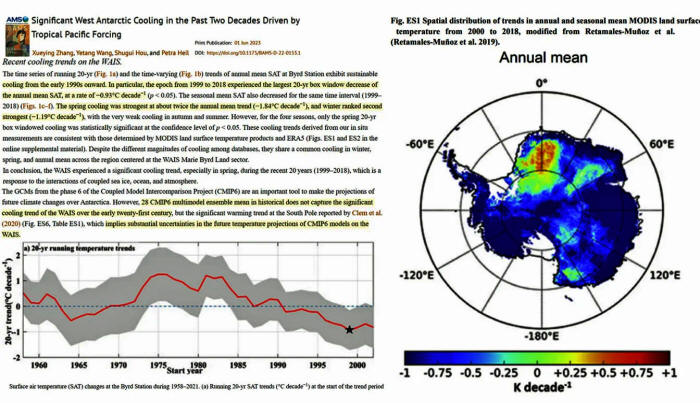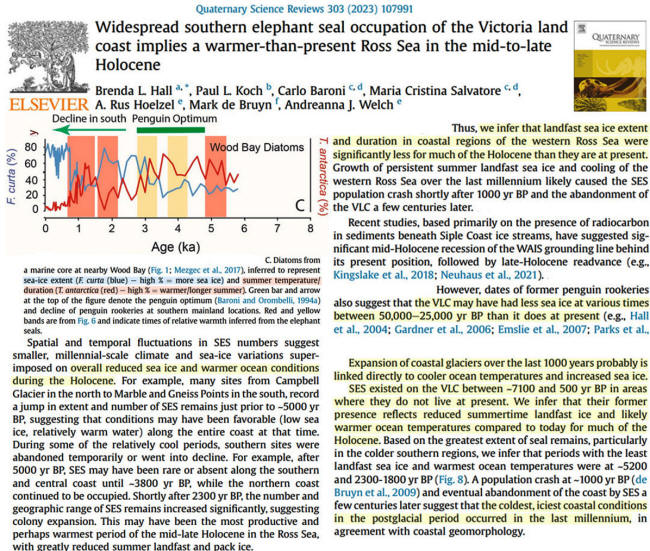|
by Kenneth Richard
West Antarctica's mean annual surface temperatures cooled by more than -1.8°C (-0.93°C per decade) from 1999-2018 (Zhang et al., 2023).
Not just West Antarctica, but most of the continent also has cooled by more than 1°C in the 21st century. See, for example, the ~1°C per decade cooling trend for East Antarctica (2000 to 2018) shown in Fig. ES1 (right).
Image Source:
According to a new study, about 6,000 years ago Antarctica's Collins Glacier's frontline was a full 1 km southwest of its current extent. The frontline advanced to today's extent ~5,000 years ago.
The glacier then continuously retreated south of the modern extent for another 4,000 years, with peak ice loss 1,000 years ago (as shown in the 1,000-year "Proglacial lake environment" image).
In the last 1,000 years, this glacier has rapidly re-advanced back to the glaciated extent from 5,000 years ago, which is in line with the sustained cooling trend ongoing since the Medieval Warm Period.
Image Source:
Throughout the Holocene (Medieval Warm Period, Roman Warm Period, and earlier) and until a few hundred years ago (from ~7,100 to 500 years before the present), coastal Antarctica's Victoria Land (VLC) was substantially warmer than today.
The Ross Sea was also sufficiently ice-free to allow for elephant seal populations (as large as ~200,000 individuals) to thrive at 73-78°S.
Today, however, elephant seal populations - which require extended sea ice-free sea waters to breed, forage, and provide nourishment for their pups - can no longer subsist anywhere even remotely close to the coasts of the Antarctic continent. It is now too cold and the sea ice is too extensive.
The substantially reduced number of remaining elephant seals existing today can only survive on subantarctic islands (South Georgia, Macquarie) at southern South American latitudes (~54.5°S) situated 2,400 kilometers north of VLC (Koch et al., 2019).
The "genetically distinct" VLC elephant seal populations that endured throughout the Holocene and even through Medieval times have tragically died off in the last few centuries due to the modern-era cooling gradient and subsequent ice cover expansion (Hall et al., 2023).
Image Source:
And with the modern sea surface temperatures cooling and southern hemisphere sea ice expansion in recent decades, even the subantarctic islands in the South Pacific that SES are limited to occupying today may not be sufficiently warm and ice-free to accommodate remaining populations.
Today's southern elephant seals are thus ironically threatened by cooling in the era of anthropogenic global warming.
Interestingly, Hall et al. also report that not only have the last few centuries (including the present) been "the coldest, iciest conditions in the post-glacial period" (see the blue sea ice and red temperature trend lines on the Holocene timeline), but even the last glacial period had periods (~50,000 to 25,000 years ago) with less sea ice than today, allowing SES to occupy the VLC coast.
Image Source:Hall et al., 2023
|






